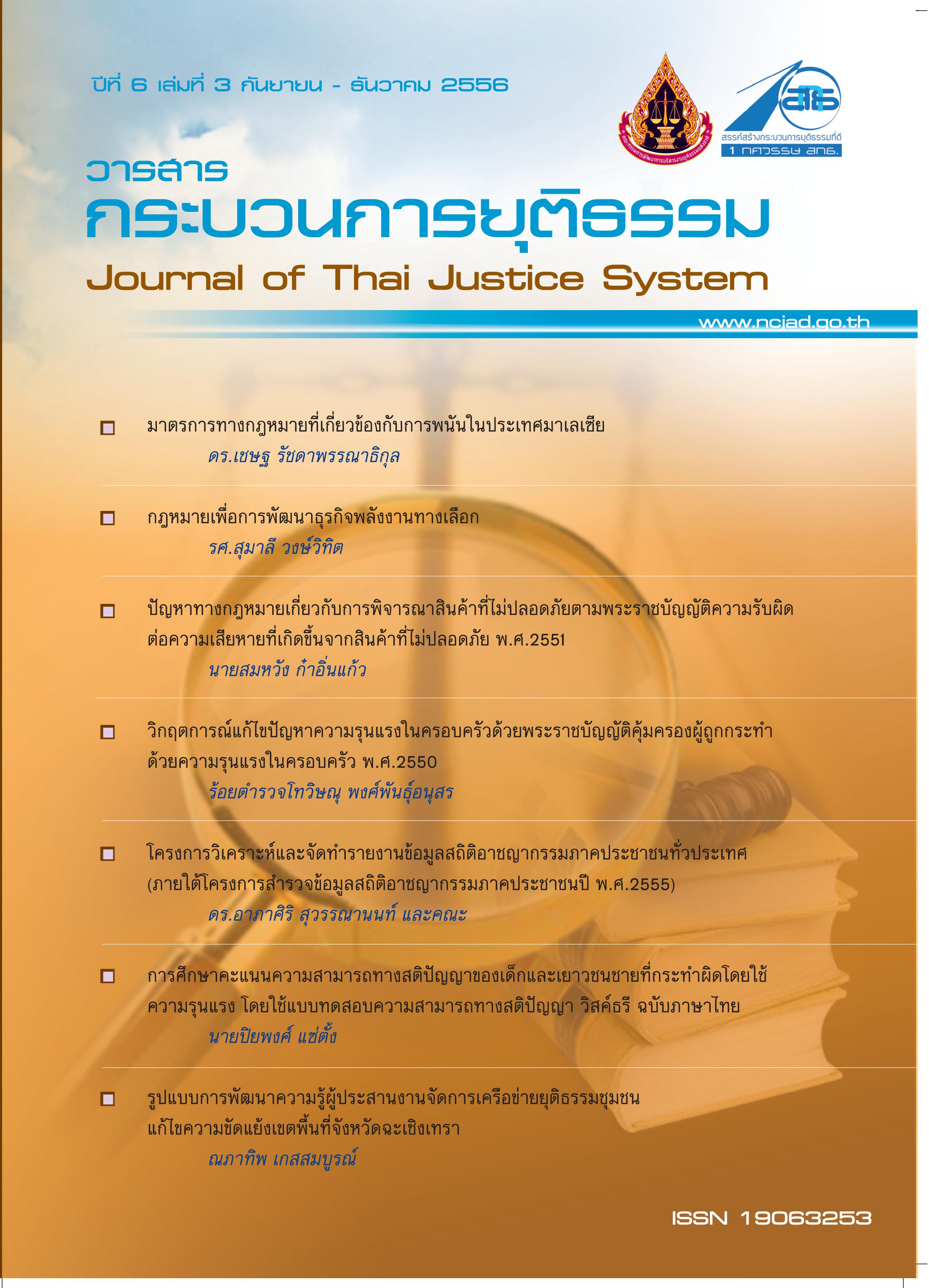โครงการวิเคราะห์และจัดทำรายงานข้อมูลสถิติอาชญากรรมภาคประชาชนทั่วประเทศ (ภายใต้โครงการสำรวจข้อมูลสถิติอาชญากรรมภาคประชาชน ปีพ.ศ.๒๕๕๕)
Main Article Content
Abstract
Exploration of the victimization crime statistical survey project was a systematic crime study from the victims to the crime nationwide. Office of Justice Affairs, Ministry of Justice of Thailand has realized the importance of victimization crime data.
In the year 2012, Ministry of Justice of Thailand by Office of Justice Affairs in cooperation with Thailand's National Statistical Office has been organized to explore the information about victims of crime around the country in every provice.
Office of Justice Affairs in cooperation with Suan Dusit Rajabhat University of Thailand have analyzed the data and prepared a report on the results of the survey and discoverd the significant key findings in 4 types of crime as follows: crime against property, crime against life and body, sexual crime and crime to falsely use/personal documents.
This paper described the results of most of crime victim in the year 2008 and 2012 mostly was crime against property followed by crime against life and body, the crime of falsely using the personal information/documents and sexual crim respectively both in and outside the municipalities.
Crime occurred most frequently on a regular basis that had the potential risk of a crime victim such as working outside the house in the daytime without someone staying at home, wearing expensive jewelry ornaments or going out of the house at night,
In the year 2008 and 2012, it was found that most crime occurred at ngiht time during 6 pm to 6 am.
In the year 2008, crimes against property occur mostly were stolen at 82.10% while in the year of 2012. IT was mostly stolen as well, but increasing to 95.10% Most of the damaged property was the vehicles, including parts of vehicles both in and outside the municipal area.
In the Yrar 2008 and 2012 in the case of crime against life and body, it was mostly were body injury by abducting, surging, pushing, slapping, hitting and stinging.
In the year 2008 and 2012 on the sexual crime, it was found that the offenders mostly tried to offend and suxual offender by not using the weapons.
In the year 2008 and 2012 on the case of crime to falsely use/personal documents, it was mostly a way to use the personal data or documents without persmission to make a credit card or loan transactions. It was increased in the year 2008 was at 49.4% to 54.30% in the year 2012.
In the year 2008 and 2012 for responding to the police, most of the victim pointed that they expected to the police to arrest or punish offenders was at 77.50% and 73.70% respectively. For non - report to the police, most of the victim pointed that the police did not know when the incident occurred at 65.20% while in the survey in 2012 up to 66.60% and Manslaughter.
Training for the interviewer should be filed before an operation, especially in the area of sexual crime in order to understand the queries and the ability to collect in-deptth information effectively.
The Importance of reconciliation and alternative judiciary process policy would be realized to reduce the number of crime victims in the judiciary process.
The increasing of the role of local authorities as is a unit of the village that can help victims of crime and to mediatte solutions to crime victims, especially crime against life and body, the sexual crime and domestice violence action.
Article Details
Published Manuscripts are the copyright of the Journal of the Justice System. However; the opinions that appeared in the content are the sole responsibility of the author.
References
รัตนะ วรบัณฑิตและสมศักดิ์ ศรีสันติสุข. 2554. วัฒนธรรมรองของเด็กที่ไม่กระทำความผิดซ้ำ. วิทยานิพนธ์ปริญญาดุษฎีบัณฑิต,มหาวิทยาลัยขอนแก่น.
ปุระชัย เปี่ยมสมบูรณ์. 2531. อาชญาวิทยา:สหวิทยาการว่าด้วยปัญหาอาชญากรรม. กรุงเทพฯ : โรงพิมพ์จุฬาลงกรณ์มหาวิทยาลัย
สำนักงานกิจการยุติธรรม. 2551. รายงานข้อมูลสถิติอาชญากรรมภาคประชาชนทั่วประเทศ พ.ศ. 2550 (โครงการสำรวจปี พ.ศ. 2551).
Brantingham, Pat L.,and Paul L. Bartingham. 1990. Situational crime prevention in Practice, Canadian Journal of Criminology 32:17-40.
Burisk Robert J.1988. Social Disorganization and Theories of Crime and Delinquency : Problem and Propects. Criminology 26:519-551
Inciadi et al.1993 Street Kids, Street Drug, Street crime : An Examination of Drug use and Serious Delinquency in Miami:Belmont,Ca:Wadworth.Inc.
Jeffery, Ray C.1977. Crime Prevention through Environment Design. Second Edition. evenly Hills, C.A:Sage.
Decker et al.1993.Perceptual deterrence among active residential burglars: A Research note. Criminology 31(1) 135-147
Cohen, Lawrence E.and Marcus Felson. 1979. Social Change and Crime rate trends: A routine activities approach. American Sociological Review 44: 588-609.
Cohen Albert K .1955. Delinquent Boys: The Culture of Gangs. Glenocoe, III: Free Press.
Cornish, Derek B. and Ronald V.Clark. 1986. The Reasoning Criminal :Rational Choice Perspectives on Offending. New York : Springer.
Harvey Cleckley.1941. The Mask of Sanity, St Louis:V.Mosby. Gibbs, Jack. 1968. Crime, punishment, and deterrence, Southwestern Social Science Quarterly p 48:515-530
Master, Ruth and Cliff Roberson.1990. Inside Criminology. Englewood Cliffs, NewJersy:Prentice Hall.
Shoemaker, Donald J. 1999. Theories of Delinquency : An Examination of Explanation of Delinquent Behavior (2nd ed) New York:Oxford University Press.

